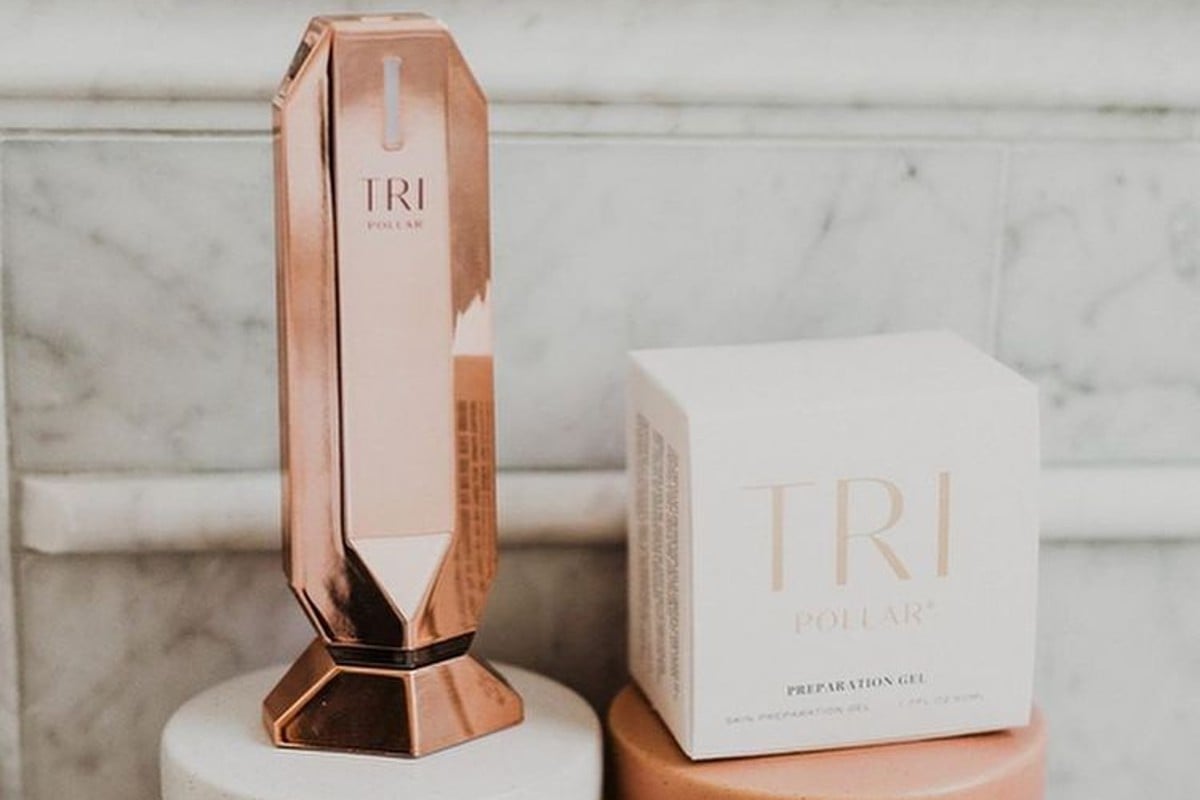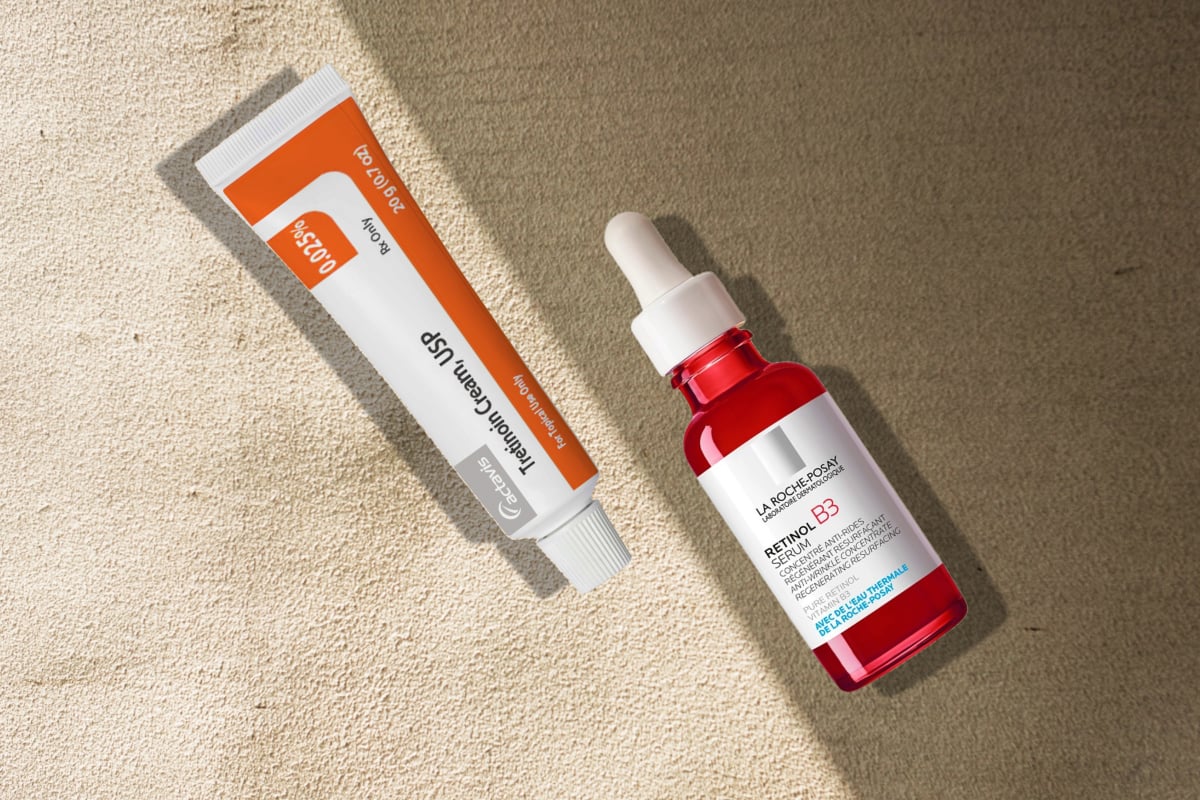- What is glycolic acid
- How glycolic acid works in skincare
- How does it benefit the skin
- Side effects of glycolic acid
- How to use glycolic acid
- Who should use glycolic acid
- Who should not use glycolic acid
- What ingredients to use with glycolic acid
Glycolic acid is a standout ingredient in the skincare scene and has earned a lot of loyal followers due to its ability to renew the skin and make it glow. Not to mention it can improve most skin conditions and nearly every dermatologist sing its praises. However, before jumping on the glycolic acid bandwagon, there are a few essential things to consider because, as good as it is, this guy comes with some caveats.
What is glycolic acid?
Glycolic acid is a water-soluble alpha-hydroxy acid derived from sugar cane. It’s considered the strongest chemical exfoliant. Glycolic acid works by breaking down the bonds between dead skin cells on the surface, allowing them to be sloughed off more rapidly.[1][2][3] This accelerates the emergence of fresh skin cells, replacing the old and damaged ones.
“Of the AHAs, glycolic is the simplest in structure and the smallest; it has the lowest molecular weight,” says Kenneth Howe, a dermatologist at Wexler Dermatology in New York City. The small molecular weight allows glycolic acid to penetrate the skin quicker than other AHAs.
How glycolic acid works
Exfoliates the skin
According to board-certified dermatologist Loretta Ciraldo, the main function of glycolic acid is to exfoliate the skin, or as she explains, it’s “ungluing dead cells from each other.” Once applied to the skin, glycolic acid reacts with the skin’s upper layer, weakening the binding lipids that hold dead cells together. In turn, this reveals brighter and smoother skin, softens fine lines and wrinkles, thickens and retexturizes the skin, and reduces the chances of acne breakouts.
Supports collagen production
Glycolic acid supports collagen and hyaluronic acid production as an extension of its ability to promote cell growth.[4] Collagen is the main protein that provides structure and strength to the skin. Hyaluronic acid is equally important as it’s responsible for the skin’s natural ability to retain moisture. By increasing the levels of these essential components, glycolic acid does everything from plumping and hydrating the skin to reducing aging signs—the reason you’ll often find it in anti-aging products.
Attracts moisture into the skin
Glycolic acid relieves dry, flakey skin thanks to its humectant activity. A humectant is a compound that can bind and attract water molecules from the atmosphere to the skin, replenishing moisture and giving the skin a supple appearance. And so glycolic acid does that by increasing the synthesis of glycosaminoglycans, molecules that draw water into the skin.[1]
Improves acne
Glycolic acid is a potent acne-fighter, and for a good reason. By eliminating dead skin cells, glycolic acid clears the pores and removes excess oil and bacteria that can lead to breakouts. But that’s not all. Its antibacterial and anti-inflammatory benefits pack quite a punch and make it a true superhero for anyone with acne-prone skin.[2] In fact, one study showed that after 12 weeks, a 35% glycolic acid peel reduced both inflammatory and non-inflammatory acne by up to 70%.[3]
Reduces hyperpigmentation
If you’re dealing with hyperpigmentation—be it dark spots or post-acne blemishes—the brightening effects of glycolic acid will definitely get in handy. It turns out glycolic acid has two mechanisms to improve skin discoloration. Firstly, it sheds off old and pigmented cells, making room for new brighter ones to replace them. Secondly, glycolic acid supress the production of pigment that causes dark patches on the skin.[5]
Enhances skin penetration
Glycolic acid enhances skin penetration by removing the buildup of dead cells from the surface. This creates a clearer path for other products to penetrate deeper into the skin, increasing their efficacy. Simply put, glycolic acid amplifies the benefits of your skincare routine.
Glycolic acid benefits for skin
All things considered, this is how using products with glycolic acid can benefit your skin and lead to a healthier, more radiant complexion:
- Resurface the skin and remove dead cells
- Stimulate collagen and hyaluronic acid production
- Diminish fine lines and wrinkles
- Tighten and firm
- Soften and smooth rough texture
- Brighten dark spots and enhance radiance
- Unclog pores and prevent blackheads
- Improve acne
- Hydrate and plump the skin
- Enhance skin penetration
Side effects of glycolic acid
When you first use glycolic acid, or if you have sensitive skin, you might notice some side effects. Your skin might peel, which is expected. But you might also feel itching, burning, or stinging. This happens because the new skin cells don’t have the same protection as the old ones. This makes the skin more delicate and easily hurt. Also, glycolic acid can make your skin more sensitive to sunlight. So, it’s a good idea to use products with glycolic acid at night and follow with sunscreen in the morning.
Glycolic acid can also cause a temporary side effect called “skin flushing” or “purging”. This happens because of the increased cell turnover, which brings excess oil and bacteria to the skin’s surface.
However, most side effects go away on their own as your skin adjusts to glycolic acid and gets accommodated with the changed rate of cell turnover. To mitigate the risk of irritation, start with a low concentration of glycolic acid and gradually increase it to give the skin time to adjust. Overuse or using high concentrations of glycolic acid can worsen the side effects.
How to use glycolic acid?
Glycolic acid is found in all sorts of skincare products, so the best approach is to use it according to the directions of the product at hand. As a rule of thumb, cleansers and toners with glycolic acid can be used daily to clear the skin of impurities and dead cells. On the other hand, serums and facial peels with high amounts of glycolic acid should be used at most three times a week after cleansing and before moisturizing.
Here are some dermatologist-approved advice for using glycolic acid:
- Start with a low concentration of glycolic acid (<2%) and gradually increase it as the skin builds tolerance. Face washes, toners, or moisturizers infused with glycolic acid are great for the accommodation period since they’re gentler and work to prepare your skin for more potent serums or facial peels.
- Perform a test patch before you apply glycolic acid to your face. Apply a small spot under your chin and leave it for 30 seconds. Rinse with water and wait for 48 hours to notice if your skin experience redness or irritation.
- Use a rich moisturizer or night cream infused with replenishing ingredients (ceramides, cholesterol, fatty acids) right after glycolic acid to boost recovery.
- Apply sunscreen every day. Since glycolic acid can make skin more sensitive to the sun, it’s crucial to wear sunscreen daily.
Who should use glycolic acid
Anyone should regularly exfoliate their skin, especially since dead cells can worsen wrinkles, pimples, discoloration, and skin texture. Thus, glycolic acid is ideal for most people, and you should head toward it whenever you feel your skin is dull or rough, it’s breaking out, or you want to get rid of dark spots or scars left by breakouts.
Who should not use glycolic acid
You should avoid using high concentrations of glycolic acid if you have very dry or sensitive skin since it can lead to irritations. The same goes if you have rosacea, eczema, or sunburn. Consider the seasonal factor too. During the summer, glycolic acid makes skin sensitive to sunlight. On the other hand, in the cold season, glycolic acid can act more aggressively for some since the skin’s barrier is at risk. Last but not least, don’t use glycolic acid after a chemical peel or microneedling.
What can you pair glycolic acid with?
Glycolic acid pairs well with hydrating and replenishing ingredients, such as hyaluronic acid, ceramides, and fatty acids. Here are a few examples of what you can pair glycolic acid with to address your skin concerns.
- Glycolic acid with niacinamide to increase skin tolerance: Glycolic acid weakens the skin’s epidermal barrier. Niacinamide rebuilds this barrier, so it can make your skin more tolerant to glycolic acid.
- Resveratrol with glycolic acid to improve uneven skin tone: Both ingredients brighten dark spots by reducing melanin production.[6]
- Retinol with glycolic acid to ward off aging signs: Both stimulate cell turnover and boost collagen in the skin. However, it’s essential to add them gradually into your routine. The best method to use glycolic acid and retinol together is to apply them on alternative nights, or what is best known as skin cycling.
- Azelaic acid with glycolic acid to reduce breakouts: It is known that azelaic acid and glycolic acid are as effective as tretinoin for acne treatment.[7][8]
- Hyaluronic acid with glycolic acid to improve hydration: This duo works great for getting rid of dullness and dryness. While glycolic acid removes dead cells, hyaluronic acid hydrates and reduces the potential drying effects of glycolic acid.
- Vitamin C with glycolic acid to fight the loss of firmness: They both boost skin-firming proteins like collagen. However, you shouldn’t mix vitamin C and glycolic acid together as they can alter your skin’s pH. For the best, use vitamin C in the morning and leave your glycolic acid product for your nighttime routine.
What not to pair with glycolic acid
You should steer clear from using glycolic acid together with other exfoliants like salicylic acid or drying actives like benzoyl peroxide.
You ask, we answer
- Can I use glycolic acid daily?
It’s perfectly fine to use a cleanser or toner with glycolic acid daily. However, serums or peels with a concentration of 5-10% glycolic acid should be used 2-3 times a week to avoid damaging your skin barrier.
- Should I moisturize after glycolic acid?
Yes, moisturizing after using glycolic acid reduces dryness and offsets irritation.
- Which is better salicylic acid or glycolic acid?
While both ingredients are exfoliating acids, they work slightly differently. Glycolic acid sloughs off dead skin from the surface, making it a good option for normal and dry. Salicylic acid goes beneath the outer skin layer, dislodging the gunk that clogs pores, which means it is a better option for oily and acne-prone skin.
Footnotes
Women’s Concepts uses reliable sources, including dermatologists’ insights, clinical trials, and scientific journals, to find accurate information and support all the facts shared in our articles. All statements and claims have clear and legit references. Read our editorial policy to learn more about our sources of information, our process of researching and fact-checking the content, and how our team strives to keep all articles updated, completed, and trustworthy.
- Kornhauser A, Coelho SG, Hearing VJ. Applications of hydroxy acids: classification, mechanisms, and photoactivity. Clin Cosmet Investig Dermatol. 2010 Nov 24, https://www.ncbi.nlm.nih.gov/pmc/articles/PMC3047947/
- Valle-González ER, Jackman JA, Yoon BK, Mokrzecka N, Cho NJ. pH-Dependent Antibacterial Activity of Glycolic Acid: Implications for Anti-Acne Formulations. Sci Rep. 2020 May 4;10(1):7491. doi: 10.1038/s41598-020-64545-9. PMID: 32367064; PMCID: PMC7198592.
- Sarkar R, Ghunawat S, Garg VK. Comparative Study of 35% Glycolic Acid, 20% Salicylic-10% Mandelic Acid, and Phytic Acid Combination Peels in the Treatment of Active Acne and Postacne Pigmentation. J Cutan Aesthet Surg. 2019 Jul-Sep;12(3):158-163. doi: 10.4103/JCAS.JCAS_135_18. PMID: 31619887; PMCID: PMC6785964.
- Bernstein EF, Lee J, Brown DB, Yu R, Van Scott E. Glycolic acid treatment increases type I collagen mRNA and hyaluronic acid content of human skin. Dermatol Surg. 2001 May;27(5):429-33. doi: 10.1046/j.1524-4725.2001.00234.x. PMID: 11359487.
- Usuki A, Ohashi A, Sato H, Ochiai Y, Ichihashi M, Funasaka Y. The inhibitory effect of glycolic acid and lactic acid on melanin synthesis in melanoma cells. Exp Dermatol. 2003;12 Suppl 2:43-50. doi: 10.1034/j.1600-0625.12.s2.7.x. PMID: 14756523.
- Jo DJ, Seok JK, Kim SY, Park W, Baek JH, Kim YM, Boo YC. Human skin-depigmenting effects of resveratryl triglycolate, a hybrid compound of resveratrol and glycolic acid. Int J Cosmet Sci. 2018 Apr 16. doi: 10.1111/ics.12458. Epub ahead of print. PMID: 29663438.
- Spellman MC, Pincus SH. Efficacy and safety of azelaic acid and glycolic acid combination therapy compared with tretinoin therapy for acne. Clin Ther. 1998 Jul-Aug;20(4):711-21. doi: 10.1016/s0149-2918(98)80134-3. PMID: 9737831.
- Kakita LS, Lowe NJ. Azelaic acid and glycolic acid combination therapy for facial hyperpigmentation in darker-skinned patients: a clinical comparison with hydroquinone. Clin Ther. 1998 Sep-Oct;20(5):960-70. doi: 10.1016/s0149-2918(98)80077-5. PMID: 9829447.




![Does resveratrol in red wine benefit your skin? While sipping on a glass of red wine can be a delightful experience, relying on it for skincare benefits is not the best idea. Sure, red wine contains a smidge of resveratrol, but let's put things into perspective. The concentration of resveratrol in red wine is relatively low. Red wines, specifically Pinot noir from France, typically contain 0.361-1.972 mg of resveratrol per liter.[8] To hit that reference dose of 500mg of resveratrol, you'd need to drink a lot of wine. We're talking about downing anywhere from 100 to 1000 glasses per day. It's a scene straight out of a wine lover's wildest dreams, but definitely not the healthiest approach. Resveratrol Benefits for Skin](https://womensconcepts.com/wp-content/uploads/2022/03/Resveratrol-Benefits-for-Skin.jpg)
